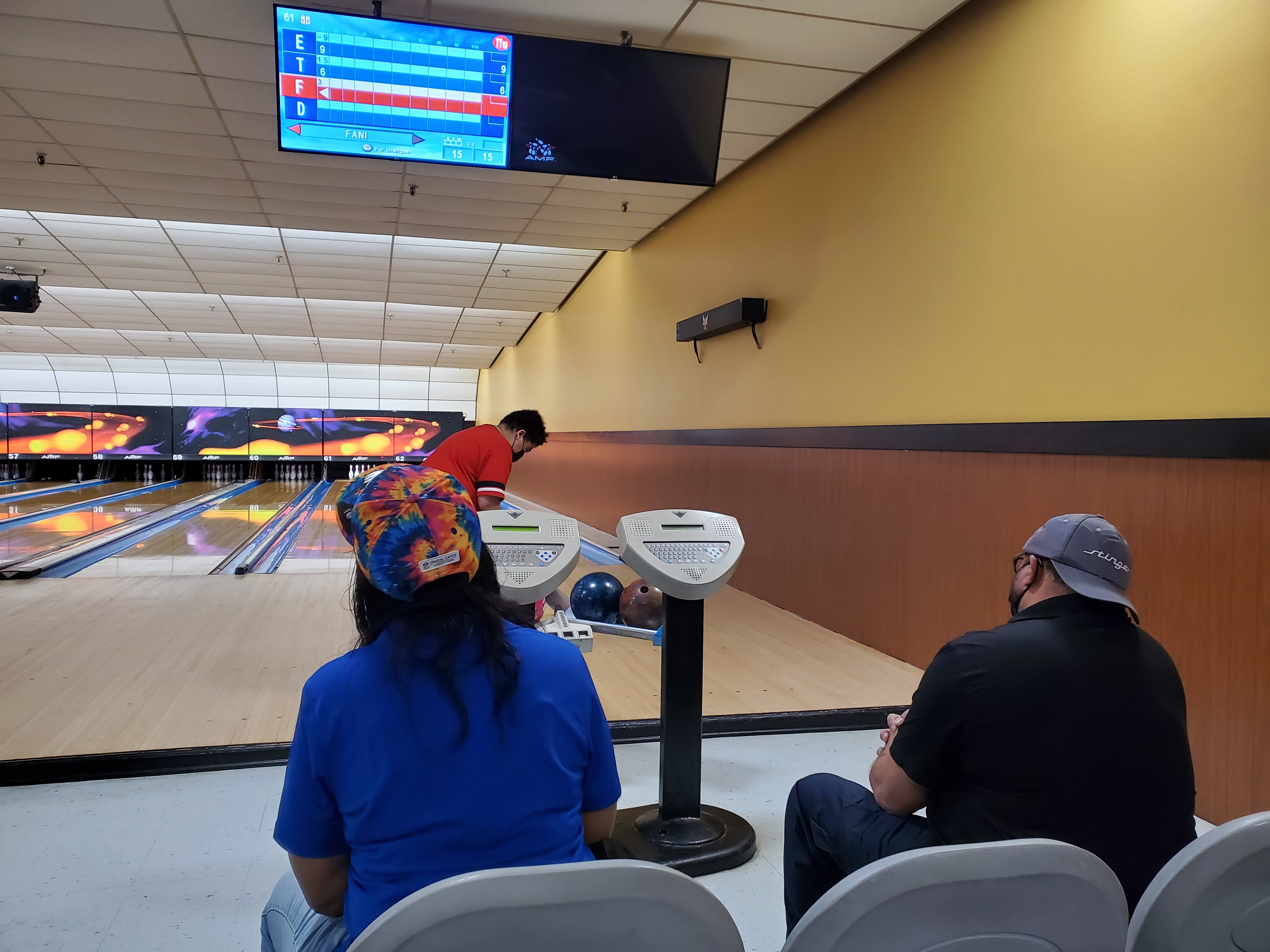As the name suggests, 9 pin bowling is a form of bowling that is played with 9 pins instead of 10. It used to be the most popular form of the sport that was played in the US. The game was astronomically popular in the early 1800s. It had such a large following that the game was subsequently banned due to gambling and people skipping out on work to play it. It was eventually overtaken by 10 pin bowling which is the more popular sport now. 9 pin bowling now is only played in parts of Texas and Europe now. Another name for 9 pin bowling is skittles.
What’s the difference between 9 pin and 10 pin bowling?
Although both are bowling sports, they are two very different games. Scoring for skittles(9 pin bowling) depends on how you knock the 9 pins down. Each formation has a different score, and some pins while standing, such as the kingpin, carry more points.
In 10 pin bowling, all pins carry only one point, and the object is to knock them down. Multipliers are awarded to players depending on whether they’re knocked down in one frame, which is called a strike or two, which is called a spare. The number of frames or turns is also different. In 10 pin bowling, players are given 2 except for the last set in which players are given 3. While in skittles(9 pin bowling), players are given 3 each set.
The equipment in both games is also different. Pins in skittles(9 pin bowling) are more grounded and short and stout, while 10 pin bowling has lighter taller pins. The balls in 9 pin bowling are also significantly smaller than standard-sized bowling balls.

The games have two significantly defiant throwing styles and strategies. While the best course of action in 10 pin bowling is to always ensure you knock down all the pins, in 9 pin bowling, leaving some pins standing may award more points than knocking them all down. These games are also played differently. The usual 10 pin bowling is played as a single-player game, and 9 pin was played commonly as a team sport.
Why was 9 pin bowling illegal?
Standardised rules and organisation of nine-pins were developed by the American Bowling Congress in 1895. Nine pin bowling was by far the most popular format of the game in the United States up until the 1830s; this is because, around this time, there was a panic created.
There was allegedly a large number of people who had stopped going to work just to play this game. There was also allegedly a lot of gambling going on in the sport. Out of ethical and moral concern, the game was made illegal. The common form of bowling then began to gain its mainstream popularity. It was more commonly played in England before this.
Today, nine-pins has disappeared from all of the United States except Texas, where, by 1837, ninepin alleys were numerous enough that rather than a ban, the 1st Congress of the Republic of Texas chose to subject them to an annual tax of $150, and all forms of bowling have remained legal and subject to taxation in Texas ever since. Whereas tenpin alleys were usually found in saloons and other establishments frequented exclusively by men, ninepin alleys were often built by clubs patronised by families.
Is 9 pin bowling still a thing?

9 pin bowling is still played in Texas due to the regulation of the game in 1837. The game itself is played there competitively at a lower level. The popularity of the game is significantly diminished. After the ban, the only area in the United States where it was played was Texas. The game is more widely played in Europe. Europe has had 9 pin bowling flourish over the years. There are dedicated leagues and tournaments held across a wide array of competitions.
What are the rules of 9 pin bowling?
9 pin bowling is played in a league format in different clubs. These bowling clubs typically have league bowling Monday through Friday, this all depending on the number of available bowling lanes and the number of league bowlers. The smaller clubs or establishments have only four lanes while the bigger clubs may have eight or more lanes to accommodate more players. League bowling consists of two teams bowling against each other for three games, with each team having six bowlers. Each game consists of six frames or turns in total.
The rules of this game are slightly more complex than the European version. Each bowler will roll the ball twice in each frame irrespective of the number of pins knocked down on each roll. When a bowler’s turn is completed, the next bowler will not receive a reset of pins to bowl at. Instead, the next bowler must attempt to knock down the pins that were left by the previous bowler.
An example is if the first bowler is only able to knock down 4 pins, the second bowler must attempt to knock down the remaining 4 pins. Should the next bowler be unsuccessful in knocking down both of these pins in the given two rolls, the third bowler will attempt to knock down the remaining pins. This will continue until the remaining pins are knocked down or until the end of the frame. Once all pins are knocked down, the 12-pin/Redhead is left standing alone, or the end of the frame is reached, all nine pins will be reset.
Another thing that makes nine-pin bowling different from ten pin bowling is that the bowlers do not have to bowl in the same order in each frame. Each team can choose a bowler to “Captain” each game. This captain has complete discretion of choice in determining the bowling order in each frame.
These decisions are made depending on the situation. If the remaining pins are on the right side, and there is a remaining bowler who is better than the rest on the right side pins, the captain will prefer to select that bowler. This gives the captain the flexibility to help increase the team’s score. However, each bowler must roll two balls in each frame.
The pins used in the Texas version of nine pins are similar in size to those used in ten pins, and the bowlers use ten-pin balls, with finger and thumb holes drilled in them.
The pins are set up in a diamond (1-2-3-2-1) configuration. The pin exactly in the centre has a special purpose in nine-pin bowling. This pin is typically painted red, either as a stripe on the pin or completely, and is called the “12-Pin” or the “Redhead”. From front to back, the pins are 1) the Head Pin, 2) the Left Front Beer and Right Front Beer Pins, 3) the Left Corner, the 12-Pin/Redhead, and the Right Corner, 4) the Left Back Beer and Right Back Beer Pins, and, finally, 5) the Sleeper Pin.
Scoring in nine-pin is also different. Each frame begins with a full house. This is a term for a frame of all pins standing. If a bowler knocks down all nine pins in a full house, that bowler achieved a nine-ringer and is given a score of 9 with a circle around it. Note that the circle is just to show that this was accomplished in a single shot or throw. There are no additional points for this feat, however. If a bowler knocks down all the pins except for the centre pin in a full house, that bowler achieved a twelve-ringer and is given a score of 12 with a circle around it. Again, the circle does not add additional points; it simply shows that a ringer was bowled.
If a bowler’s roll does not result in either “9” or “12” points, that bowler’s roll is given a “-“ (dash) or a “√” (check), which carries no point value. The one exception to this is the last ball rolled by the last bowler in the frame. This bowler will receive credit for the number of pins knocked down. For example, if the last bowler has rolled his second ball for this frame, and three pins remain standing (six pins knocked down), that bowler will receive credit for those six pins, regardless if that bowler knocked these six pins down or not.
When a bowler takes a turn and knocks down the remaining pins, that bowler receives nine points for that shot, regardless of the number of pins knocked down to receive these nine points. If a bowler knocks down the remaining pins, except for the centre pin, that bowler receives 12 points for that shot regardless of the number of pins knocked down to receive those 12 points.

Because bowlers face the pins their teammates have left, the better teams are those who have a mix of bowlers that can “hit the left side”, “hit the right side”, or can “roll ringers”. This leads to “specialization”. A good team “Captain” can also help their team by sending the bowlers in the order that maximizes their success.
Typical nine-pin league bowling teams have both male and female bowlers with ages that span from teenagers up to 80- and 90-year-old great-grandparents. It is not unheard of for an 80-something grandmother to be on a bowling team because “she can hit the left side every time”.


